
Finland, officially the Republic of Finland, is a Nordic country in Northern Europe. It shares land borders with Sweden to the northwest, Norway to the north, and Russia to the east, with the Gulf of Bothnia to the west and the Gulf of Finland to the south, across from Estonia. Finland covers an area of 338,455 square kilometres (130,678 sq mi) with a population of 5.6 million. Helsinki is the capital and largest city. The vast majority of the population are ethnic Finns. Finnish and Swedish are the official languages, Swedish is the native language of 5.2% of the population. Finland's climate varies from humid continental in the south to the boreal in the north. The land cover is primarily a boreal forest biome, with more than 180,000 recorded lakes.

Helsinki is the capital, primate, and most populous city of Finland. Located on the shore of the Gulf of Finland, it is the seat of the region of Uusimaa in southern Finland, and has a population of 658,864. The city's urban area has a population of 1,268,296, making it by far the most populous urban area in Finland as well as the country's most important center for politics, education, finance, culture, and research. Helsinki is located 80 kilometres (50 mi) north of Tallinn, Estonia, 400 km (250 mi) east of Stockholm, Sweden, and 300 km (190 mi) west of Saint Petersburg, Russia. It has close historical ties with these three cities.

Vantaa is a city and municipality in Finland. It is part of the inner core of the Finnish Capital Region along with Helsinki, Espoo, and Kauniainen. With a population of 239,216, Vantaa is the fourth most populated city in Finland after Helsinki, Espoo and Tampere. Its administrative center is the Tikkurila district. Vantaa is bordered by Helsinki, the Finnish capital, to the south; Espoo to the southwest; Nurmijärvi to the northwest; Kerava and Tuusula to the north; and Sipoo to the east. The city encompasses 240.35 square kilometres (92.80 sq mi), of which 1.97 km2 (0.76 sq mi) is water.

Turku is a city and former capital on the southwest coast of Finland at the mouth of the Aura River, in the region of Finland Proper (Varsinais-Suomi) and the former Turku and Pori Province. The region was originally called Suomi (Finland), which later became the name for the whole country. As of 31 March 2021, the population of Turku was 194,244 making it the sixth largest city in Finland after Helsinki, Espoo, Tampere, Vantaa and Oulu. There were 281,108 inhabitants living in the Turku Central Locality, ranking it as the third largest urban area in Finland after the Capital Region area and Tampere Central Locality. The city is officially bilingual as 5.2 percent of its population identify Swedish as a mother-tongue.
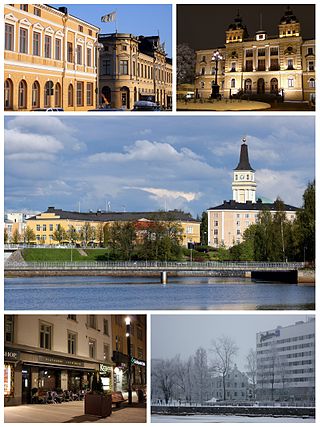
Oulu is a city, municipality and a seaside resort of about 210,000 inhabitants in the region of North Ostrobothnia, Finland. It is the most populous city in northern Finland and the fifth most populous in the country after: Helsinki, Espoo, Tampere and Vantaa, and the fourth largest urban area in the country after Helsinki, Tampere and Turku. Oulu's neighbouring municipalities are: Hailuoto, Ii, Kempele, Liminka, Lumijoki, Muhos, Pudasjärvi, Tyrnävä and Utajärvi.

Lapland is the largest and northernmost region of Finland. The 21 municipalities in the region cooperate in a Regional Council. Lapland borders the region of North Ostrobothnia in the south. It also borders the Gulf of Bothnia, Norrbotten County in Sweden, Troms and Finnmark County in Norway, and Murmansk Oblast and the Republic of Karelia in Russia. Topography varies from vast mires and forests of the South to fells in the North. The Arctic Circle crosses Lapland, so polar phenomena such as the midnight sun and polar night can be viewed in Lapland.

Hämeenlinna is a city and municipality of about 68,000 inhabitants in the heart of the historical province of Tavastia and the modern province of Kanta-Häme in the south of Finland. Hämeenlinna is the oldest inland city of Finland and was one of the most important Finnish cities until the 19th century. It remains an important regional center. The medieval Häme Castle is located in the city.

Mariehamn is the capital of Åland, an autonomous territory under Finnish sovereignty. Mariehamn is the seat of the Government and Parliament of Åland, and 40% of the population of Åland live in the city. It is mostly surrounded by Jomala, the second largest municipality in Åland in terms of population; to the east it is bordered by Lemland. Like all of Åland, Mariehamn is unilingually Swedish-speaking and around 88% of the inhabitants speak it as their native language.
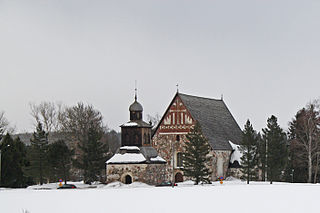
Sipoo is a municipality of Finland. It is part of the Helsinki metropolitan area. The municipality has a population of 22,186 (31 December 2021) and covers an area of 698.60 square kilometres (269.73 sq mi) of which 358.97 km2 (138.60 sq mi) is water. The population density is 65.33 inhabitants per square kilometre (169.2/sq mi). The administrative center of the municipality is Nikkilä, which is located 34 kilometres (21 mi) northeast of the center of Helsinki. Another significant urban area is Söderkulla, located in the southern part of the municipality.
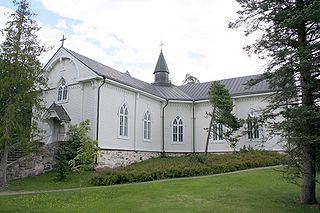
Askola is a municipality of Finland. It is located in the Uusimaa region. The municipality has a population of 4,847 and covers an area of 218.03 square kilometres (84.18 sq mi) of which 5.61 km2 (2.17 sq mi) is water. The population density is 22.82 inhabitants per square kilometre (59.1/sq mi). Monninkylä is the largest village of municipality in terms of population. Neighbouring municipalities are Myrskylä, Mäntsälä, Pornainen, Porvoo and Pukkila.

Kotka is a city in the southern part of the Kymenlaakso province on the Gulf of Finland. Kotka is a major port and industrial city and also a diverse school and cultural city, which was formerly part of the old Kymi parish; later, Kymi with the Haapasaari island and Karhula, the latter of which once separate from Kymi as the market town, were incorporated into Kotka. The neighboring municipalities of Kotka are Hamina, Kouvola and Pyhtää. Kotka belongs to the Kotka-Hamina subdivision, and with Kouvola, Kotka is one of the capital center of the Kymenlaakso region. It is the 19th largest city in terms of population as a single city, but the 12th largest city of Finland in terms of population as an urban area.
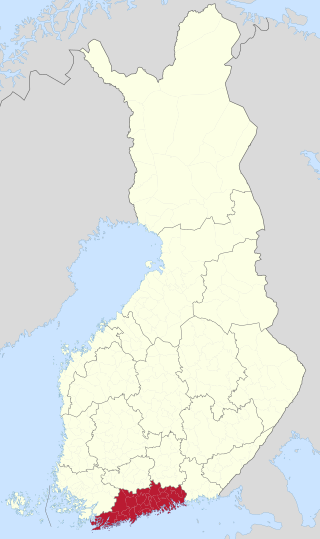
Uusimaa is a region of Finland. It borders the regions of Southwest Finland, Tavastia Proper (Kanta-Häme), Päijänne Tavastia (Päijät-Häme), and Kymenlaakso. Finland's capital and largest city, Helsinki, along with the surrounding Greater Helsinki area, are both contained in the region, and Uusimaa is Finland's most populous region. The population of Uusimaa is 1,734,000.

Järvenpää is a town and municipality in Finland. It is located on the Helsinki–Riihimäki railway track in Uusimaa region, some 37 kilometres (23 mi) north of Helsinki. Neighbouring municipalities are Tuusula, Sipoo and Mäntsälä. People also refer to Kerava as Järvenpää's neighbour, even though they do not technically share a border, thanks to the one kilometre-wide land area that belongs to Tuusula.
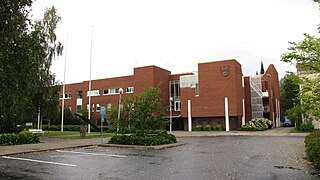
Kauhajoki is a town and municipality of Finland. It is located in the province of Western Finland and is part of the Southern Ostrobothnia region, 59 kilometres (37 mi) southwest of the city of Seinäjoki. The population of Kauhajoki is 12,889 and the municipality covers an area of 1,299.10 km2 (501.59 sq mi) of which 16.46 km2 (6.36 sq mi) is inland water. The population density is 9.92/km2 (25.7/sq mi). The town is unilingually Finnish.

The two main official languages of Finland are Finnish and Swedish. There are also several official minority languages: three variants of Sami, as well as Romani, Finnish Sign Language and Karelian.
Somalis in Finland are residents and citizens of Finland of Somali ancestry.
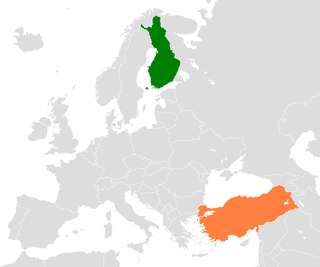
Finland–Turkey relations are foreign relations between Finland and Turkey. Finland has an embassy in Ankara and an honorary consulate general in Istanbul and other honorary consulates in Adana, Alanya, Antalya, Belek, Bodrum, İzmir, and Kayseri. Turkey has an embassy in Helsinki. Both countries are full members of the Council of Europe, the Organisation for Economic Co-operation and Development (OECD), the Organization for Security and Co-operation in Europe (OSCE) and the Union for the Mediterranean.
Romanians in Finland are immigrants from Romania residing in Finland.
Norwegians in Finland are immigrants born in Norway, citizens of Norway or speakers of the Norwegian language living in Finland.
Syrians in Finland are immigrants from Syria residing in Finland. They are the second largest Arab community in Finland after Iraqis.
















